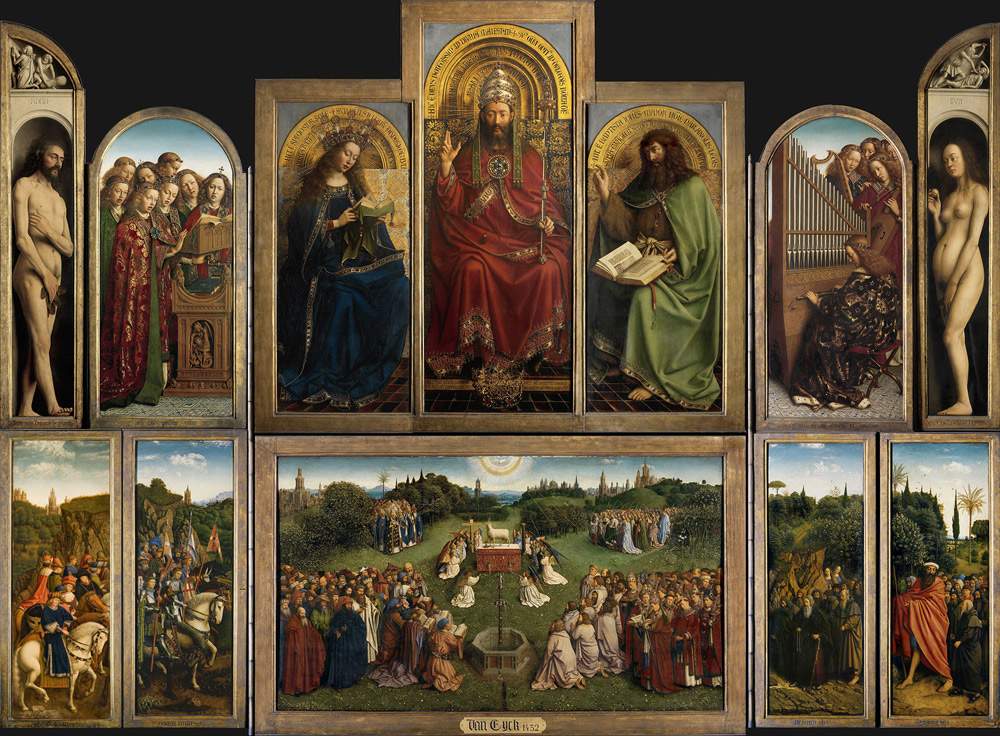The Polyptych of the Mystical Lamb, one of the greatest masterpieces of Flemish art, never ceases to amaze and gives some significant new information about it. For we know that it was made by Jan van Eyck (Maaseik, c. 1390 - Bruges, 1441) and his older brother, Hubert van Eyck (? - Ghent, 1426). Until now, however, we did not know how far one’s work had gone and where the other’s had gone: it was speculated, on the basis of the inscription (later revealed to be authentic) on the frame discovered in 1823, that Hubert had begun work on the painting and that Jan had continued it from 1426, when his brother died.
The inscription was hotly debated until 2020, when its authenticity was attested upon completion of restoration work on the lower register of the inner compartments. Now, precisely with regard to these panels of the polyptych, we are able to distinguish the work of the two brothers. Indeed, the restoration has brought to light a layer beneath that which visitors have admired for years in St. Bavon Cathedral in Ghent, where the Polyptych is preserved, and has stimulated new studies to define what exact role Hubert played.
The conclusions of these studies were released yesterday, October 13, by the interdisciplinary study by the Royal Institute for Cultural Heritage (KIK-IRPA - Brussels) and the University of Antwerp (AXIS Research Group, UA). We now know that Hubert’s original painting had important differences in composition. In the central panel, Hubert painted the sky, the hilly landscape and some buildings, as well as the cities on the horizon and the meadow-all these details are to be assigned to Hubert. In a second phase, probably following Hubert’s death in 1426, we recognize the hand of Jan van Eyck, who completed and repainted a large part of his brother’s work, but left some parts intact. The central part with the spring was repainted with the image of the large fountain we see today, and Jan also meticulously repainted the parts around some of Hubert’s figures, retouching some and adding others. Jan also intervened on the landscape, for example adding some trees and adding a blue glaze over the sky. On the city on the horizon, Jan then added the steeple of Utrecht Cathedral, St. Bavon’s Abbey, and the church of Our Lady of Bruges. In a third phase, Jan worked out additional details: for example, the dove of the Holy Spirit was ingratiated. The parts of Hubert’s original painting, most of them retouched by Jan, although covered by a later layer of varnish, can be seen with the help of state-of-the-art equipment.
The discovery sheds light on an ancient enigma but could also be a starting point and open a new chapter in the study of Flemish primitives: the search for other paintings by Hubert Van Eyck. The elder of the illustrious brothers may in fact be the “missing link” between the revolutionary art of Jan van Eyck and the so-called pre-Eyckian painting tradition. The research also provides data to start with new studies on the upper register of the open polyptych (still unstudied in this respect, as it has not yet been restored or analyzed).
“Once again, the restoration of the Ghent Altarpiece and the research that followed led to a spectacular breakthrough,” says Jan Jambon, Flanders’ minister of culture. “Today, the mystery of Hubert Van Eyck has also been solved and we can permanently honor both great Flemish artists. We are extremely curious about the discoveries that await us in the next and final phase of the restoration.”
“In recent years,” says Matthias Diependaele, Flemish Minister of Intangible Heritage, “we have invested substantially in the restoration and enhancement of both the Cathedral, with its new state-of-the-art visitor center, and the Ghent Polyptych. I am pleased to have been able to make an important contribution to putting Flemish heritage even more firmly on the international map as a tourist destination. It is therefore an obvious choice for the Flemish government to also invest in the third and final phase of restoration of the altarpiece.”
“There is no doubt that Van Eyck was a genius,” emphasizes Lode van Hecke, Bishop of Ghent. “But the same can be said of the restorers. My explicit gratitude goes to the team of the Royal Institute for Cultural Heritage: they gave a remarkable performance with great passion, patience and professionalism. They have set a milestone in the history of the Ghent Polyptych.”
 |
| Polyptych of the Mystic Lamb: Hubert van Eyck's role discovered |
Warning: the translation into English of the original Italian article was created using automatic tools. We undertake to review all articles, but we do not guarantee the total absence of inaccuracies in the translation due to the program. You can find the original by clicking on the ITA button. If you find any mistake,please contact us.